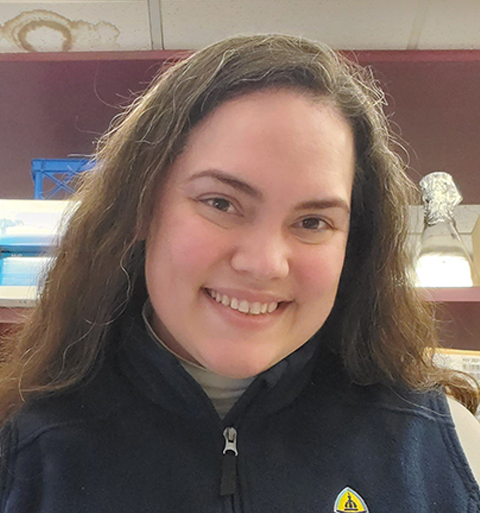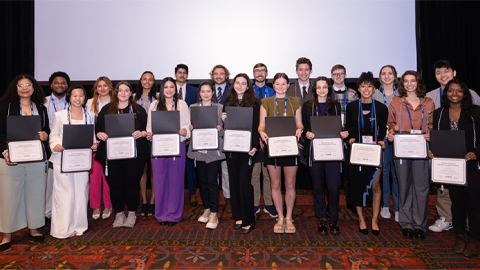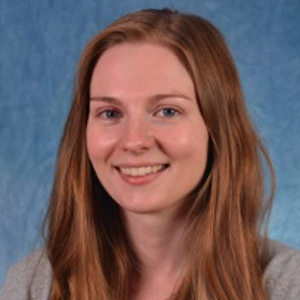
Translating the glycosylation code
Anabel Gonzalez–Gil always viewed science as bland memorization until she began a high school chemistry class.
“I had a professor that was very creative and we had a lot of experiments that were hands on,” she said. “That really caught my attention.”

Channeling that passion, Gonzalez–Gil studied chemistry at Florida International University. As an undergraduate, she spent a summer at the University of Colorado working with calcium-sensing probes.
“That was the first time I did molecular biology and that kind of shifted my career,” she said, explaining she was captivated by being able to modulate protein expression and function.
Following a postbaccalaureate program at the National Institute on Aging, she began graduate school at Johns Hopkins University and was introduced to glycosylation, a type of post-translational modification where combinations of sugars (glycans) are added to proteins or lipids.
Most cell-surface and secreted proteins in the human body are glycosylated. The structure and density of glycans on these proteins regulate receptor binding and downstream cell signaling. Gonzalez–Gil’s doctoral work focused on the immune system, studying the receptor Siglec-8 and its glycosylated ligands in the airway.
Now as a postdoctoral fellow at Johns Hopkins, Gonzalez–Gil investigates the role of glycosylation in the brain. In the future, she plans to open her own lab.
As Gonzalez–Gil reflected on her path, she emphasized the importance of teamwork in pushing science forward. “The best of my career has not been me doing things on my own,” she said. “I would like to highlight how important and how satisfying it is to be able to collaborate.”
Linking a ligand to neurodegeneration
Glycosylation is not static. The sugar groups added to a protein or lipid can be changed quickly to elicit a different cellular reaction. The quintessential example of this rapid adaptation can be seen in the immune system. While the body must engage the inflammatory response quickly to fight a pathogen, it also needs to shut down this pathway after the threat has passed.
Anabel Gonzalez–Gil’s research focuses on Siglecs, a family of receptors primarily found on immune cells. Many human Siglecs bind glycosylated ligands, launching a signaling cascade to downregulate the immune system. In recent years, Siglecs were linked to cancer cells’ evasion of the immune system and Alzheimer’s disease.
“I’m truly fascinated by the ability of glycans to modulate cellular responses in such a short time,” Gonzalez–Gil said. “If you want a different target and outcome, you just have to modify a protein’s glycans.”
She compares this process to work at a construction site. “You don't have to break down the entire house and then take the blocks and build it back up to how you want it,” she said. “You just remodel what needs to be fixed so that it can work better.”
Gonzalez–Gil and colleagues in Ronald Schnaar’s lab at the Johns Hopkins University School of Medicine discovered a glycosylated version of the protein RPTPζ that specifically binds two Siglecs on microglia, the immune cells of the brain. Their research showed that RPTPζ expression is elevated in the brains of patients diagnosed with Alzheimer’s.
The team now is working to understand the link between RPTPζ and the inflammation associated with neurological diseases, Gonzalez–Gil said.
“We are really focusing on trying to understand how the production of this ligand fine-tunes the immune system.”
“Human brain sialoglycan ligand for CD33, a microglial inhibitory Siglec implicated in Alzheimer’s disease” was published in the Journal of Biological Chemistry in June 2022. Gonzalez–Gil and other winners of the JBC Tabor Award will give talks during a symposium on Sunday, March 26, at Discover BMB in Seattle.
Enjoy reading ASBMB Today?
Become a member to receive the print edition monthly and the digital edition weekly.
Learn moreGet the latest from ASBMB Today
Enter your email address, and we’ll send you a weekly email with recent articles, interviews and more.
Latest in People
People highlights or most popular articles

Notebook scribbles to synthesis pathways
The discipline Kendrick Smith learned as a musician helps him stay focused at the bench.

ASBMB inducts new honor society members
Chi Omega Lambda, which recognizes exceptional juniors and seniors pursuing degrees in the molecular life sciences, has 31 inductees in 2024.

2024 voter guide
Learn about the candidates running for ASBMB Council, Nominating Committee, Publications Committee and treasurer.

Charles O. Rock (1949 – 2023)
Colleagues and trainees remember a world expert in membrane lipid homeostasis.

Honors for Clemons, Hatzios and Wiemer
Awards, honors, milestones and more. Find out what's happening in the lives of ASBMB members.

Touching the future from the bench
Scholar, scientist, teacher and mentor Odutayo Odunuga discusses the important roles of the institutional PI, his journey and his research.

